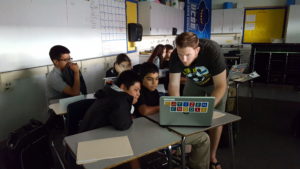Lawrence Livermore National Laboratory’s Michael Mayhew brings STEM opportunities into the classroom with Citizen Schools!
 Remember middle school? It is perhaps the most important- and most challenging- of grade levels. Aside from navigating the awkwardness of being a pre-teen, middle school is also when we began to solidify our self-identity, interests, and aspirations.
Remember middle school? It is perhaps the most important- and most challenging- of grade levels. Aside from navigating the awkwardness of being a pre-teen, middle school is also when we began to solidify our self-identity, interests, and aspirations.
Michael Mayhew, a researcher in Lawrence Livermore’s Computational Engineering division, found himself back in middle school this past fall. Only this time, he was in front of the classroom, as a volunteer “Citizen Teacher.” For 90 minutes each Thursday, Michael co-taught Android App Design, a coding and game design apprenticeship, to students at a public middle school in east San Jose. Supported by a fellow volunteer and a campus staff member, Michael guided 32 middle school students through the basics of coding and problem solving.
“The most exciting part for me,” Michael reflected, “was seeing the kids take the concepts we’d gone over and just run with them. As their apps took shape, you could see their creativity in navigating obstacles and building apps that were fun and personal.”
When Mariana, 7th grader at Renaissance Academy at Mathson, was asked about her experience in Michael’s apprenticeship, she replied “It was my first time computer coding.. The reason I liked my Android App apprenticeship was because I like to build whatever is in my imagination. I like to take something from my imagination, design it, and then build it!”
Citizen Schools mobilizes thousands of adult volunteers to help improve student achievement by teaching hands-on, skill-building apprenticeships in the hours after school. Each volunteer teaches a pre-written curriculum that highlights their passions- anything from cooking to computer science. After participating in Citizen Schools program, including apprenticeships like Android App Design, students are impacted for life. Their rate of learning accelerates and their interest in STEM fields increases, as does their odds of graduating high school on time and enrolling into college.
When thinking about how he made an impact, Michael recalled a moment when students asked Michael what exactly his job was. “I told them about some of my computer vision and deep learning work and their eyes lit up. My hope is that I’ve sparked some curiosity in them to learn more. I found my way to computer science and statistics through mentorship experiences. I believe that a few of these kids will remember their experiences and find their way to the lab.”
